HAT304: Emerging Issues in Hospitality and Tourism - Food Tourism
VerifiedAdded on 2022/08/24
|6
|978
|18
Report
AI Summary
This report examines the concept of gastronomic tourism, with a specific focus on Australia. It begins by defining gastronomic tourism and its importance, highlighting the role of gastronomic routes in creating value and promoting destinations. The report then delves into the lifestyles and motivations of gastronomic tourists, exploring their preferences for high-quality products and pleasant environments. It provides examples of popular food tourist routes in South Australia, including wineries and restaurants. Furthermore, it explores global trends in food tourism, such as the popularity of special wines and the cultural consumption of food, while also acknowledging the impact of technological advancements on food production. The report references several academic sources to support its analysis, and it provides a comprehensive overview of the key aspects of food tourism in the context of the Australian hospitality industry.
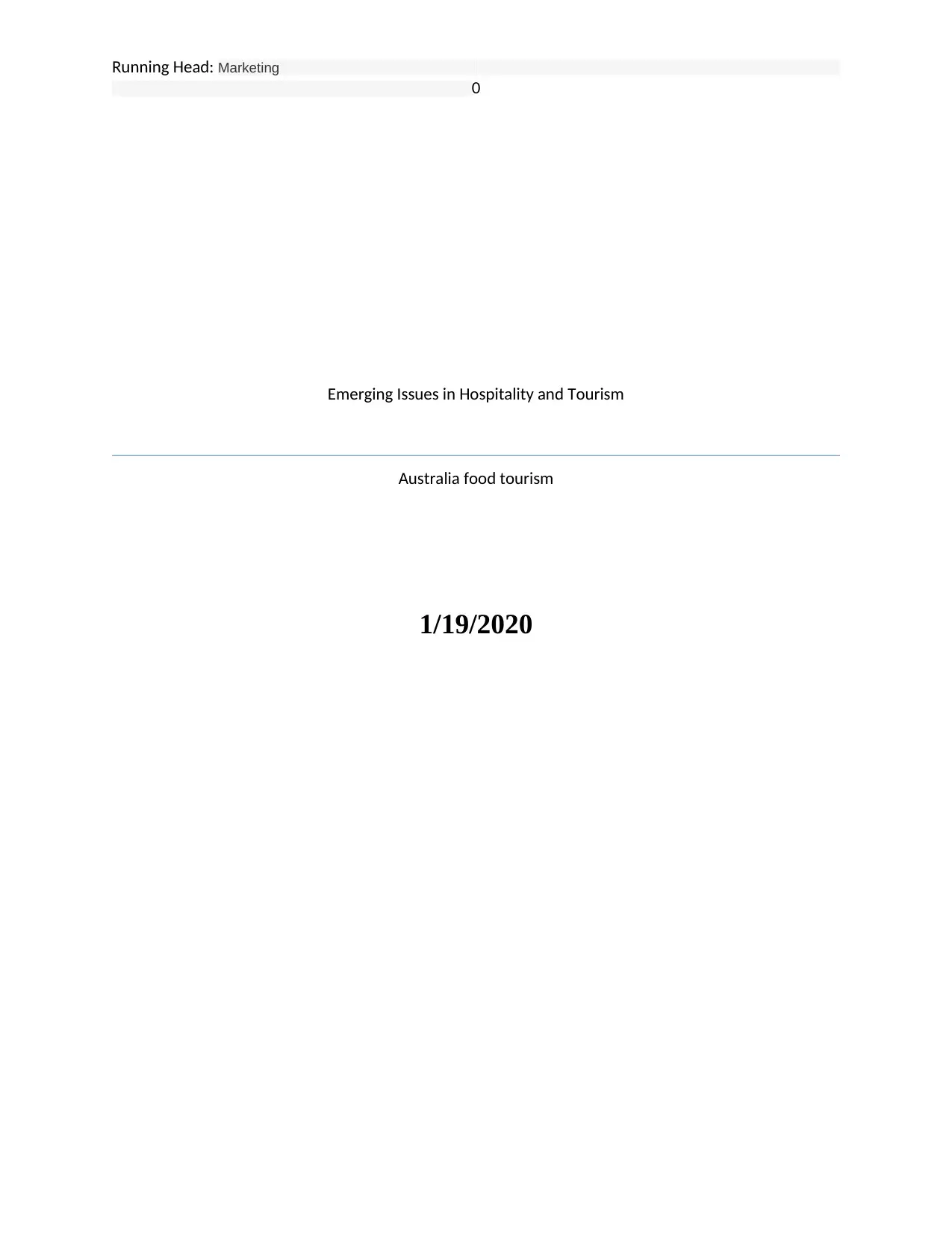
Running Head: Marketing
0
Emerging Issues in Hospitality and Tourism
Australia food tourism
1/19/2020
0
Emerging Issues in Hospitality and Tourism
Australia food tourism
1/19/2020
Paraphrase This Document
Need a fresh take? Get an instant paraphrase of this document with our AI Paraphraser
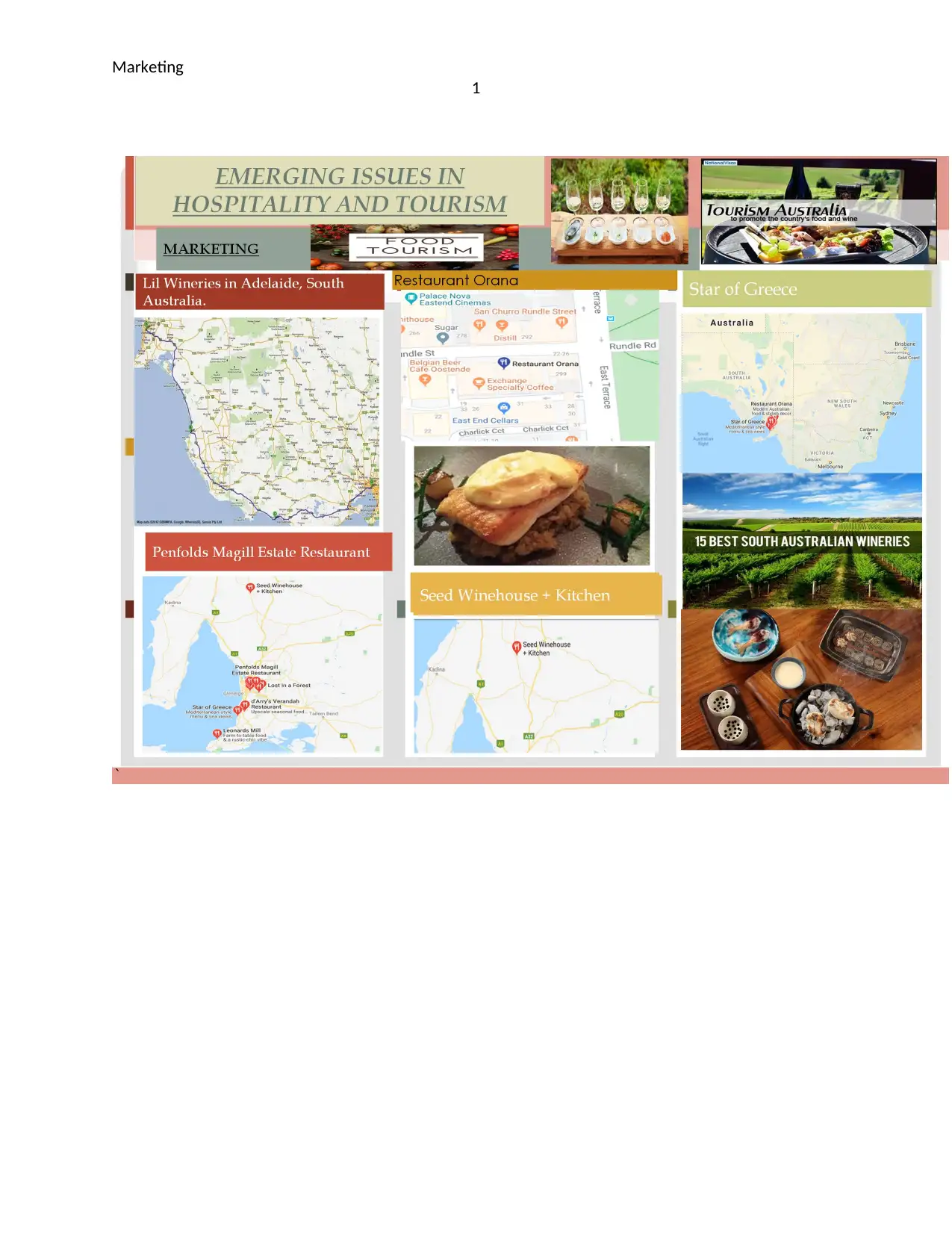
Marketing
1
1
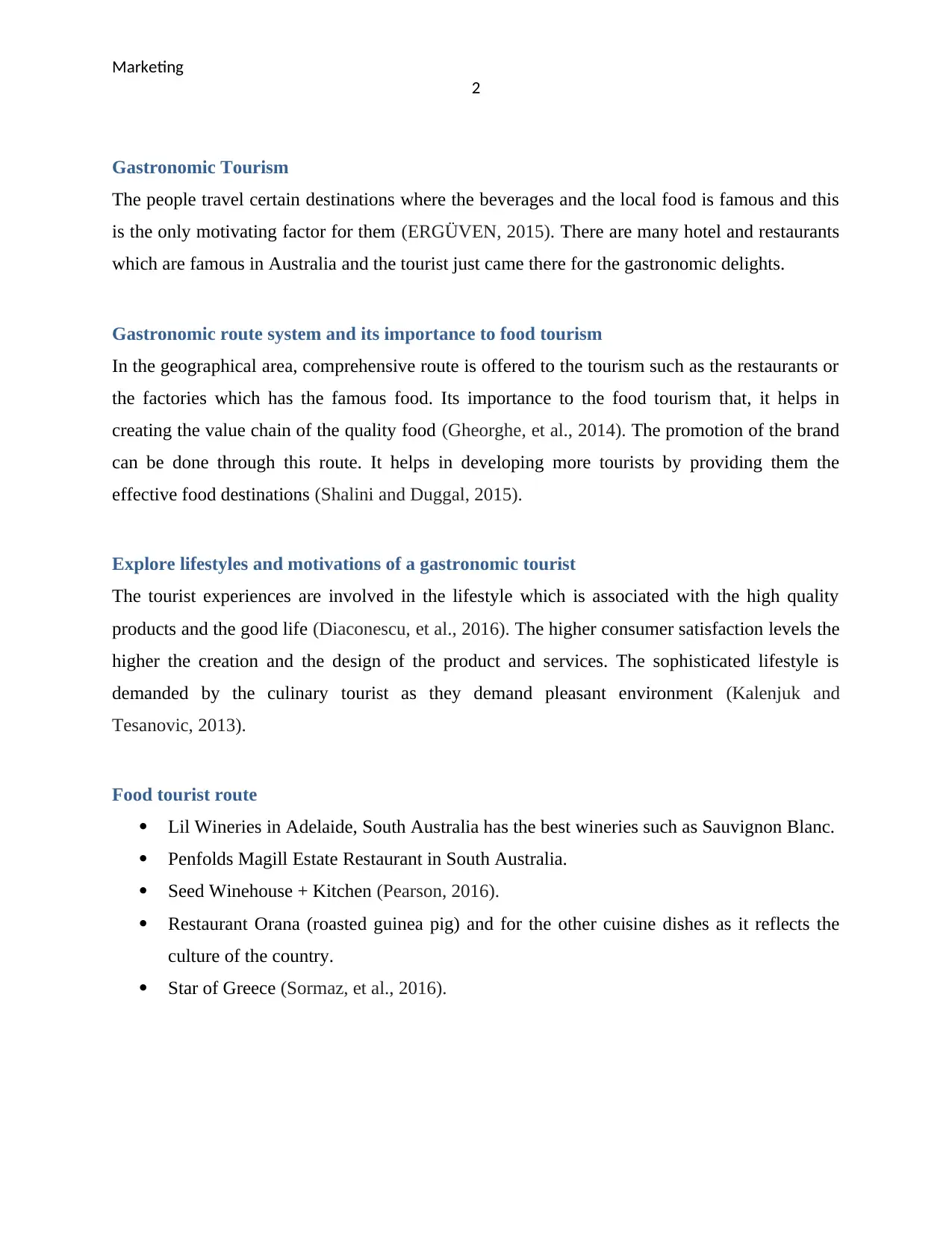
Marketing
2
Gastronomic Tourism
The people travel certain destinations where the beverages and the local food is famous and this
is the only motivating factor for them (ERGÜVEN, 2015). There are many hotel and restaurants
which are famous in Australia and the tourist just came there for the gastronomic delights.
Gastronomic route system and its importance to food tourism
In the geographical area, comprehensive route is offered to the tourism such as the restaurants or
the factories which has the famous food. Its importance to the food tourism that, it helps in
creating the value chain of the quality food (Gheorghe, et al., 2014). The promotion of the brand
can be done through this route. It helps in developing more tourists by providing them the
effective food destinations (Shalini and Duggal, 2015).
Explore lifestyles and motivations of a gastronomic tourist
The tourist experiences are involved in the lifestyle which is associated with the high quality
products and the good life (Diaconescu, et al., 2016). The higher consumer satisfaction levels the
higher the creation and the design of the product and services. The sophisticated lifestyle is
demanded by the culinary tourist as they demand pleasant environment (Kalenjuk and
Tesanovic, 2013).
Food tourist route
Lil Wineries in Adelaide, South Australia has the best wineries such as Sauvignon Blanc.
Penfolds Magill Estate Restaurant in South Australia.
Seed Winehouse + Kitchen (Pearson, 2016).
Restaurant Orana (roasted guinea pig) and for the other cuisine dishes as it reflects the
culture of the country.
Star of Greece (Sormaz, et al., 2016).
2
Gastronomic Tourism
The people travel certain destinations where the beverages and the local food is famous and this
is the only motivating factor for them (ERGÜVEN, 2015). There are many hotel and restaurants
which are famous in Australia and the tourist just came there for the gastronomic delights.
Gastronomic route system and its importance to food tourism
In the geographical area, comprehensive route is offered to the tourism such as the restaurants or
the factories which has the famous food. Its importance to the food tourism that, it helps in
creating the value chain of the quality food (Gheorghe, et al., 2014). The promotion of the brand
can be done through this route. It helps in developing more tourists by providing them the
effective food destinations (Shalini and Duggal, 2015).
Explore lifestyles and motivations of a gastronomic tourist
The tourist experiences are involved in the lifestyle which is associated with the high quality
products and the good life (Diaconescu, et al., 2016). The higher consumer satisfaction levels the
higher the creation and the design of the product and services. The sophisticated lifestyle is
demanded by the culinary tourist as they demand pleasant environment (Kalenjuk and
Tesanovic, 2013).
Food tourist route
Lil Wineries in Adelaide, South Australia has the best wineries such as Sauvignon Blanc.
Penfolds Magill Estate Restaurant in South Australia.
Seed Winehouse + Kitchen (Pearson, 2016).
Restaurant Orana (roasted guinea pig) and for the other cuisine dishes as it reflects the
culture of the country.
Star of Greece (Sormaz, et al., 2016).
⊘ This is a preview!⊘
Do you want full access?
Subscribe today to unlock all pages.

Trusted by 1+ million students worldwide
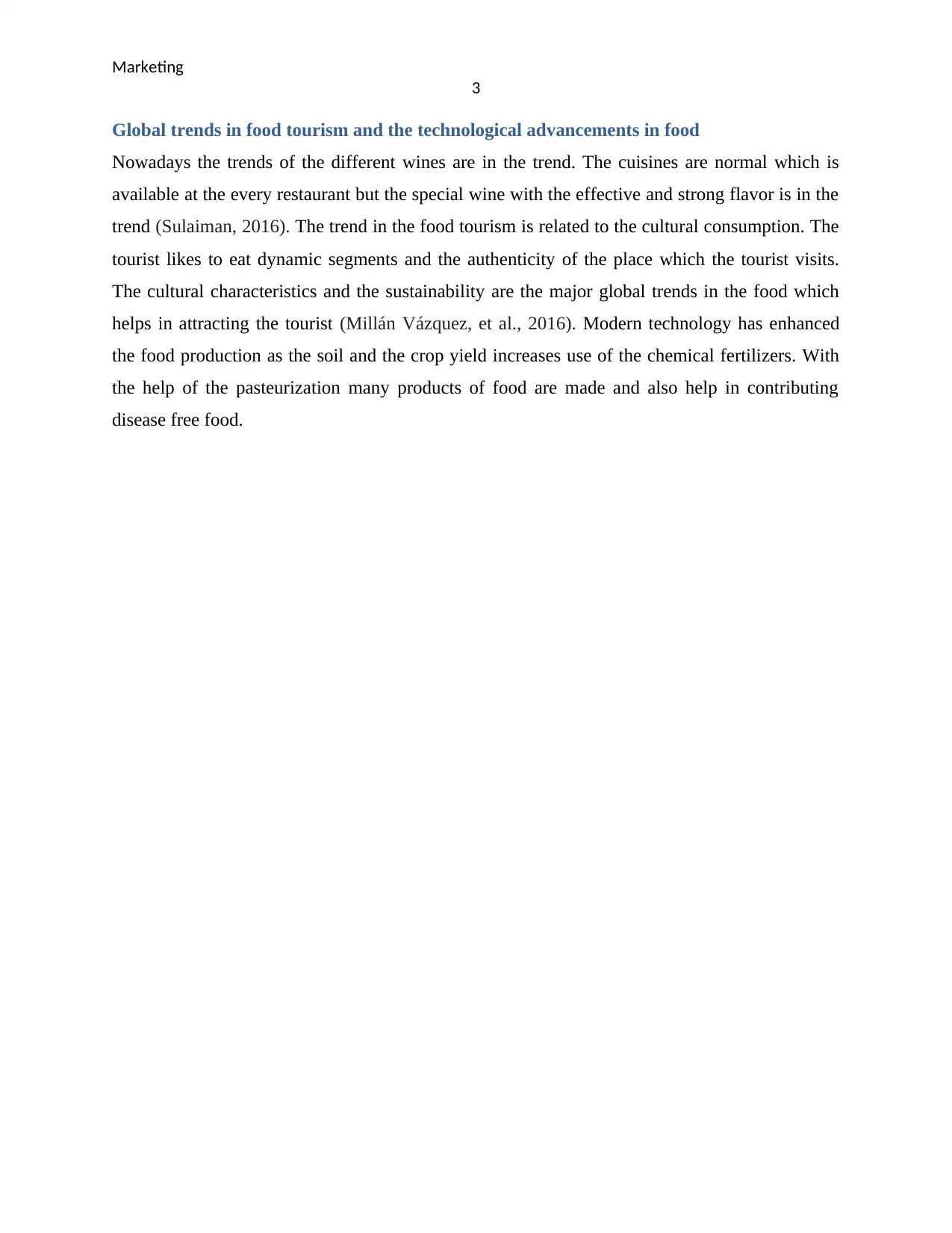
Marketing
3
Global trends in food tourism and the technological advancements in food
Nowadays the trends of the different wines are in the trend. The cuisines are normal which is
available at the every restaurant but the special wine with the effective and strong flavor is in the
trend (Sulaiman, 2016). The trend in the food tourism is related to the cultural consumption. The
tourist likes to eat dynamic segments and the authenticity of the place which the tourist visits.
The cultural characteristics and the sustainability are the major global trends in the food which
helps in attracting the tourist (Millán Vázquez, et al., 2016). Modern technology has enhanced
the food production as the soil and the crop yield increases use of the chemical fertilizers. With
the help of the pasteurization many products of food are made and also help in contributing
disease free food.
3
Global trends in food tourism and the technological advancements in food
Nowadays the trends of the different wines are in the trend. The cuisines are normal which is
available at the every restaurant but the special wine with the effective and strong flavor is in the
trend (Sulaiman, 2016). The trend in the food tourism is related to the cultural consumption. The
tourist likes to eat dynamic segments and the authenticity of the place which the tourist visits.
The cultural characteristics and the sustainability are the major global trends in the food which
helps in attracting the tourist (Millán Vázquez, et al., 2016). Modern technology has enhanced
the food production as the soil and the crop yield increases use of the chemical fertilizers. With
the help of the pasteurization many products of food are made and also help in contributing
disease free food.
Paraphrase This Document
Need a fresh take? Get an instant paraphrase of this document with our AI Paraphraser
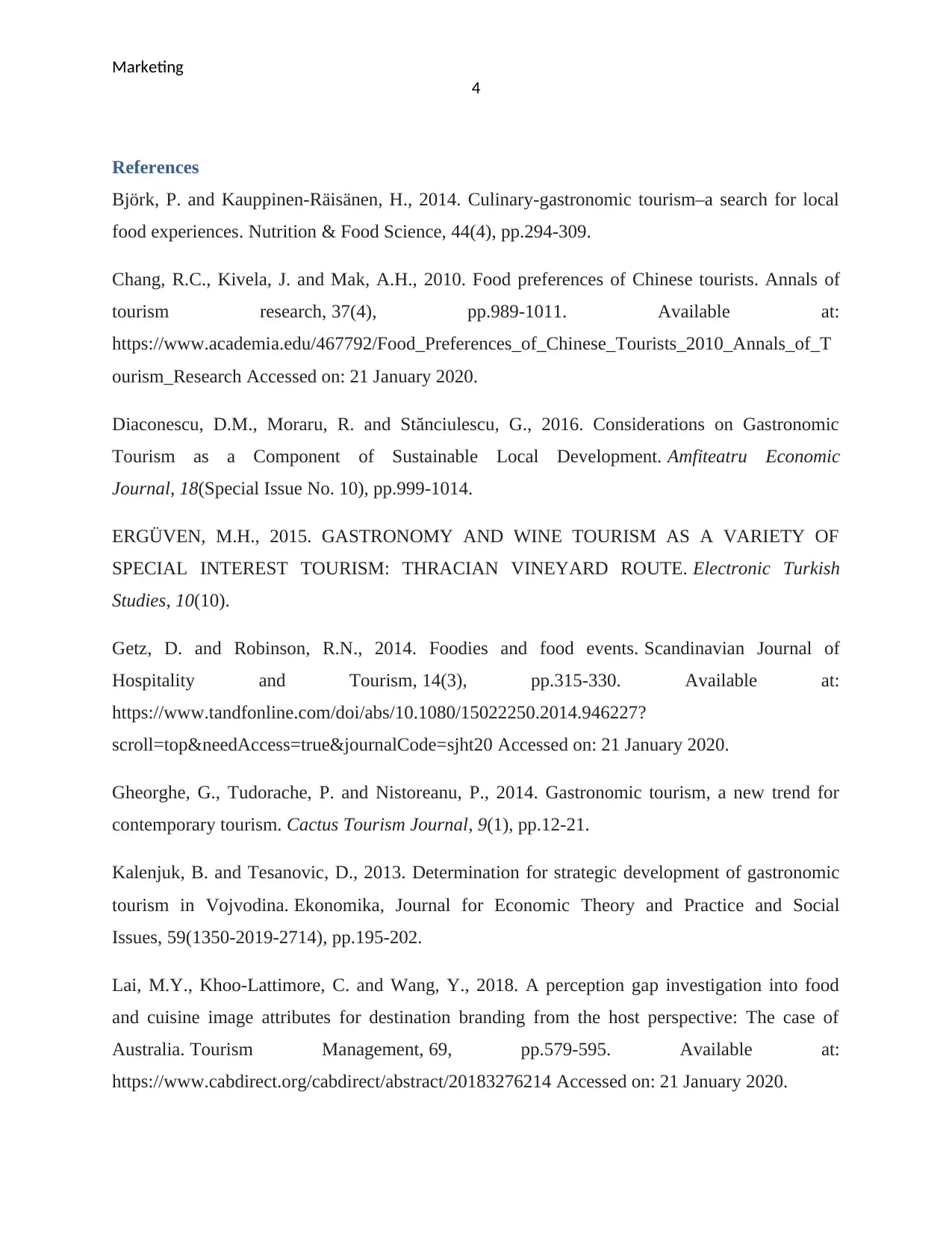
Marketing
4
References
Björk, P. and Kauppinen-Räisänen, H., 2014. Culinary-gastronomic tourism–a search for local
food experiences. Nutrition & Food Science, 44(4), pp.294-309.
Chang, R.C., Kivela, J. and Mak, A.H., 2010. Food preferences of Chinese tourists. Annals of
tourism research, 37(4), pp.989-1011. Available at:
https://www.academia.edu/467792/Food_Preferences_of_Chinese_Tourists_2010_Annals_of_T
ourism_Research Accessed on: 21 January 2020.
Diaconescu, D.M., Moraru, R. and Stănciulescu, G., 2016. Considerations on Gastronomic
Tourism as a Component of Sustainable Local Development. Amfiteatru Economic
Journal, 18(Special Issue No. 10), pp.999-1014.
ERGÜVEN, M.H., 2015. GASTRONOMY AND WINE TOURISM AS A VARIETY OF
SPECIAL INTEREST TOURISM: THRACIAN VINEYARD ROUTE. Electronic Turkish
Studies, 10(10).
Getz, D. and Robinson, R.N., 2014. Foodies and food events. Scandinavian Journal of
Hospitality and Tourism, 14(3), pp.315-330. Available at:
https://www.tandfonline.com/doi/abs/10.1080/15022250.2014.946227?
scroll=top&needAccess=true&journalCode=sjht20 Accessed on: 21 January 2020.
Gheorghe, G., Tudorache, P. and Nistoreanu, P., 2014. Gastronomic tourism, a new trend for
contemporary tourism. Cactus Tourism Journal, 9(1), pp.12-21.
Kalenjuk, B. and Tesanovic, D., 2013. Determination for strategic development of gastronomic
tourism in Vojvodina. Ekonomika, Journal for Economic Theory and Practice and Social
Issues, 59(1350-2019-2714), pp.195-202.
Lai, M.Y., Khoo-Lattimore, C. and Wang, Y., 2018. A perception gap investigation into food
and cuisine image attributes for destination branding from the host perspective: The case of
Australia. Tourism Management, 69, pp.579-595. Available at:
https://www.cabdirect.org/cabdirect/abstract/20183276214 Accessed on: 21 January 2020.
4
References
Björk, P. and Kauppinen-Räisänen, H., 2014. Culinary-gastronomic tourism–a search for local
food experiences. Nutrition & Food Science, 44(4), pp.294-309.
Chang, R.C., Kivela, J. and Mak, A.H., 2010. Food preferences of Chinese tourists. Annals of
tourism research, 37(4), pp.989-1011. Available at:
https://www.academia.edu/467792/Food_Preferences_of_Chinese_Tourists_2010_Annals_of_T
ourism_Research Accessed on: 21 January 2020.
Diaconescu, D.M., Moraru, R. and Stănciulescu, G., 2016. Considerations on Gastronomic
Tourism as a Component of Sustainable Local Development. Amfiteatru Economic
Journal, 18(Special Issue No. 10), pp.999-1014.
ERGÜVEN, M.H., 2015. GASTRONOMY AND WINE TOURISM AS A VARIETY OF
SPECIAL INTEREST TOURISM: THRACIAN VINEYARD ROUTE. Electronic Turkish
Studies, 10(10).
Getz, D. and Robinson, R.N., 2014. Foodies and food events. Scandinavian Journal of
Hospitality and Tourism, 14(3), pp.315-330. Available at:
https://www.tandfonline.com/doi/abs/10.1080/15022250.2014.946227?
scroll=top&needAccess=true&journalCode=sjht20 Accessed on: 21 January 2020.
Gheorghe, G., Tudorache, P. and Nistoreanu, P., 2014. Gastronomic tourism, a new trend for
contemporary tourism. Cactus Tourism Journal, 9(1), pp.12-21.
Kalenjuk, B. and Tesanovic, D., 2013. Determination for strategic development of gastronomic
tourism in Vojvodina. Ekonomika, Journal for Economic Theory and Practice and Social
Issues, 59(1350-2019-2714), pp.195-202.
Lai, M.Y., Khoo-Lattimore, C. and Wang, Y., 2018. A perception gap investigation into food
and cuisine image attributes for destination branding from the host perspective: The case of
Australia. Tourism Management, 69, pp.579-595. Available at:
https://www.cabdirect.org/cabdirect/abstract/20183276214 Accessed on: 21 January 2020.
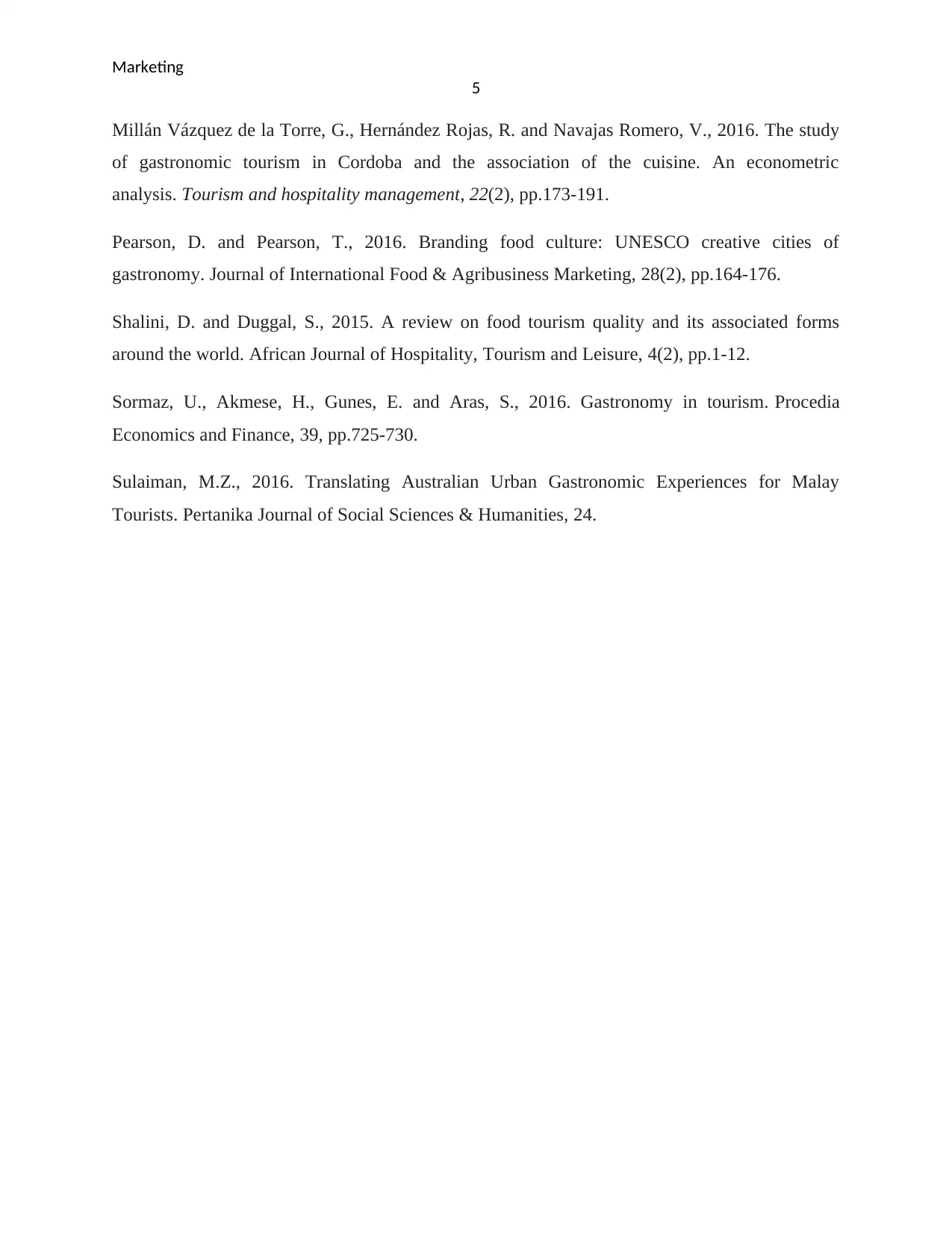
Marketing
5
Millán Vázquez de la Torre, G., Hernández Rojas, R. and Navajas Romero, V., 2016. The study
of gastronomic tourism in Cordoba and the association of the cuisine. An econometric
analysis. Tourism and hospitality management, 22(2), pp.173-191.
Pearson, D. and Pearson, T., 2016. Branding food culture: UNESCO creative cities of
gastronomy. Journal of International Food & Agribusiness Marketing, 28(2), pp.164-176.
Shalini, D. and Duggal, S., 2015. A review on food tourism quality and its associated forms
around the world. African Journal of Hospitality, Tourism and Leisure, 4(2), pp.1-12.
Sormaz, U., Akmese, H., Gunes, E. and Aras, S., 2016. Gastronomy in tourism. Procedia
Economics and Finance, 39, pp.725-730.
Sulaiman, M.Z., 2016. Translating Australian Urban Gastronomic Experiences for Malay
Tourists. Pertanika Journal of Social Sciences & Humanities, 24.
5
Millán Vázquez de la Torre, G., Hernández Rojas, R. and Navajas Romero, V., 2016. The study
of gastronomic tourism in Cordoba and the association of the cuisine. An econometric
analysis. Tourism and hospitality management, 22(2), pp.173-191.
Pearson, D. and Pearson, T., 2016. Branding food culture: UNESCO creative cities of
gastronomy. Journal of International Food & Agribusiness Marketing, 28(2), pp.164-176.
Shalini, D. and Duggal, S., 2015. A review on food tourism quality and its associated forms
around the world. African Journal of Hospitality, Tourism and Leisure, 4(2), pp.1-12.
Sormaz, U., Akmese, H., Gunes, E. and Aras, S., 2016. Gastronomy in tourism. Procedia
Economics and Finance, 39, pp.725-730.
Sulaiman, M.Z., 2016. Translating Australian Urban Gastronomic Experiences for Malay
Tourists. Pertanika Journal of Social Sciences & Humanities, 24.
⊘ This is a preview!⊘
Do you want full access?
Subscribe today to unlock all pages.

Trusted by 1+ million students worldwide
1 out of 6
Related Documents
Your All-in-One AI-Powered Toolkit for Academic Success.
+13062052269
info@desklib.com
Available 24*7 on WhatsApp / Email
![[object Object]](/_next/static/media/star-bottom.7253800d.svg)
Unlock your academic potential
Copyright © 2020–2025 A2Z Services. All Rights Reserved. Developed and managed by ZUCOL.




